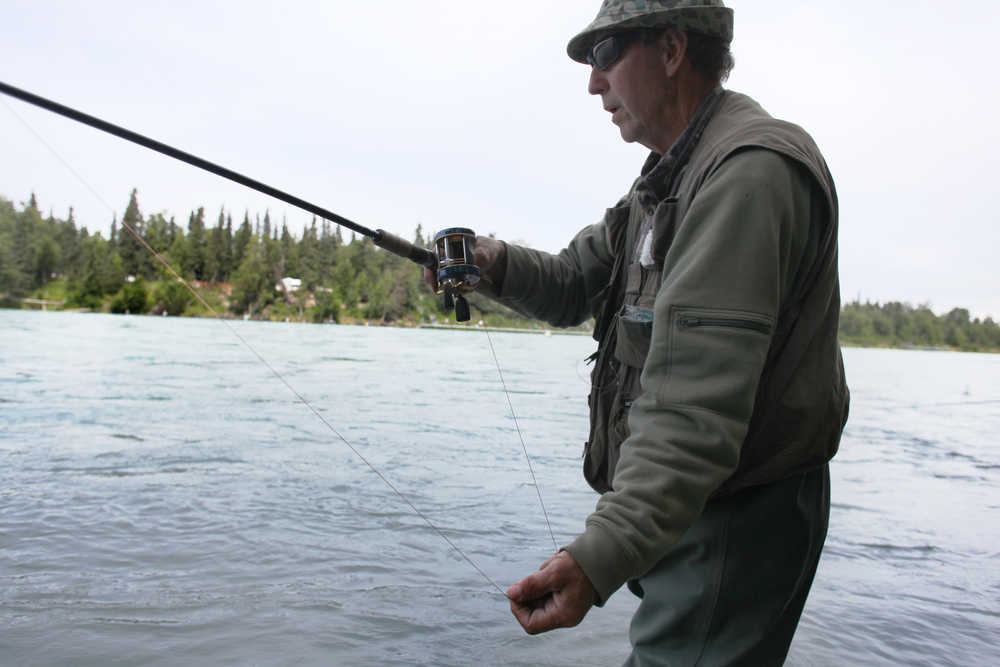While dipnetters swarm the Kenai Peninsula’s beaches to wrestle fish out of the surf, anglers take to the riverbanks to practice a less athletic but more nuanced type of fishing.
Scott Miller, co-owner of Soldotna’s Trustworthy Hardware and Fishing store, said pulling sockeye from the river requires a “fairly simple set-up” — a sharp yarned hook and a weight “as light as you can be, while still getting on the bottom” — and some less-simple techniques to account for salmon behavior.
One such technique is “the Kenai twitch” — also known as “flossing” because ideally, it will involve the angler pulling a line between a salmon’s teeth. Because salmon do not habitually bite at objects while traveling up river, it takes some extra effort to plant a hook in a sockeye’s mouth. After flipping the hook up-stream and allowing it to drift downstream (hopefully attracting a salmon’s attention on the way), the angler jerks the line before flipping it back upstream.
“Most of the fish, you’re going to feel them down at the end of your drift,” Miller said. “So you come up and set the hook. That’s the Kenai twitch you’re talking about there.”
For an angler with a sharp hook and a good twitch, the two other essentials are location and time.
“You want fast water in front of you,” Miller said. “In fast water they’re going to be right on the bottom and closer to the shore line. When you get in an eddy, or soft water, they’ll spread out, and it’s almost impossible to catch them at that point.”
As for timing, Miller said it has been an especially crucial element in this year’s fishery.
“We expect fishing to be pretty consistent throughout the day, and that hasn’t necessarily been the case,” Miller said. “It seems like we get big peaks and valleys with this push. … You kind of have to be there when it’s coming through.”
Miller said the Cook Inlet’s tide is the most likely indicator of when a pulse of fish may come through.
“You’ve got to time those fish off that tide,” Miller said. “They come in off that high tide, then you’ve got to time them as they go up the river. Hopefully you’re in the right spot at the right time.”
On the banks of the Kenai below the access stairs at Soldotna’s Kenai River Center, fisherman Sam Gotter, of Portland, Oregon, agreed the fish were coming in “pulses.” Gotter said he had been on the bank since early Tuesday morning, when anglers on the bank had suddenly begun getting hits.
“It started about 5, 5:30,” Gotter said. “A lot of people caught them when the pulses were there. Between, it was just a few. A lot of limits went out. And they were big enough that they were breaking mainlines.”
Upriver from Gotter, standing in the Kenai behind Soldotna’s Kenai River Center, fisherman Art Baker executed the flossing technique with a personal twist: while drifting the hook he holds the mainline by hand, and at the end of the drift pulls in nearly an arm’s length of line for an especially big twitch. He said holding the line helps him feel what’s happening on the other end.
“Some people don’t keep their fingers on the line, but I like to,” Baker said. “It lets me feel whenever they take it. Some people can feel through the end of their rod, but I don’t feel it that way. I feel it at the line.”
Although this year’s escapement has been below level of the 30,000 to 50,000 fish per day, which he said was essential for consistent fishing, Miller said there is still good fishing to be found on the river.
“The fact that we saw big numbers for a couple of days kind of calmed people down,” Miller said. “They’re starting to get out there and fish instead of just worrying about whether or not it’s going to be here.”
Reach Ben Boettger at ben.boettger@peninsulaclarion.com.

